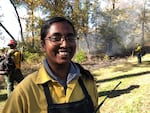This past weekend in a forested area outside Eugene, a group of Native American firefighter trainees carried out a prescribed burn. That’s a deliberate and controlled fire, often called a “cultural burn” by Native people as it follows methods practiced by their ancestors. And the tradition is making a comeback.
On the Andrew Reasoner Wildlife Preserve, the trainees were joined by personnel from 10 organizations, including the Confederated Tribes of the Grand Ronde, and the Oregon Department of Forestry.
Dressed in yellow and green fatigues, as well as hard hats and fire-resistant boots, the trainees systematically applied drip-torches to an 8-acre stretch of forest. Orange flames quickly spread among the madrones and Ponderosa pines. Engine crews stood by should any flame escape the fire lines.
Katie MacKendrick is an ecologist with the Long Tom Watershed Council, one of the groups that has planned this event for nearly four years.
“We’re in our second half of an Indigenous fire practitioner training, where 15 people are learning how to be basic firefighters,” she told KLCC. “So they’ll have an FFT-2 qualification. Which means they can go work for an agency, a tribe, as a wildland firefighter or here locally, participate in prescribed burns.”

Trainees and personnel gather on the edge of an 8-acre burn on the Andrew Reasoner Wildlife Preserve on Oct. 16, 2021.
Brian Bull / KLCC
MacKendrick estimates about $20,000 has funded this training, from numerous groups and foundations (OWEB, The Collins Foundation, Oregon Community Foundation, Oregon Prescribed Fire Council, donations collected through McKenzie River Trust during a talk by Robin Wall Kimmerer, and contributions from Confederated Tribes of Grand Ronde, The Nature Conservancy, and OSU Extension.)
MacKendrick also said the initiative seeks to reduce barriers to participation in controlled burns at the community level, acknowledging the right Native people have to work with fire.
Until recently, these burns would have been unthinkable, even banned. 20th century firefighting by federal and state agencies focused on immediate wildfire suppression, not setting fires to reduce slash and vegetation. They’ve engaged in campaigns such as the need to protect timber during World War II as a valuable resource, and the enduring Smokey Bear. But early Natives set these “good fires” to prevent much larger ones, and to rejuvenate certain plants.
“For instance, the women that used to pick the huckleberries, which we call iwam, they would burn — every four years — the huckleberry stands to bring back more iwam,” explained Derek Kimbol, a Klamath Modoc tribal member.
Kimbol’s with a nonprofit group called Maqlaqs Gee’tkni, meaning “Place of the People.” He brought several youth along to share Indigenous fire practices, which were suppressed for generations after colonization.
“So with the loss of the knowledge through history, that’s played a big part in what we’re seeing today with the devastation of the megafires and the dying of the forest.”
After more than a century of wildfire suppression, many incidents have been catastrophic in size and intensity. Accumulated slash and vegetation — combined with a hotter and drier climate — have sparked monstrous fires including this year’s Dixie Fire in California, which to date, has burned more than 963,000 acres.
“Test fire successful, and we’ll continue ignition,” reported Amanda Rau on a walkie-talkie to division leaders. Rau is an Oregon State University professor who specializes in regional fires across the Cascades and Willamette Valley. She served as “burn boss” for the Ecostudies Institute this weekend, a nonprofit group based in Washington that helped with training.
“The idea is to change the mindset that most people have about fire, which is one of fear. And change that to an empowered mindset around how to use fire, how to employ it, and how to relate to land and culture through it.”
To that end, the tribal trainees’ families — including children — were invited to watch the burn, to view fire more as a tool, versus something to be feared.

Esther Jose, a Ph.D student who observed the burn and talked to participants. She says an economic case can be made to utilize early fire control measures like cultural burns, which may sway policy more than moral arguments.
Brian Bull / KLCC
There were also other observers, including Esther Jose, a Ph.D student in Operations Research from the University of Buffalo in New York. She’s making the case that burns like this one will pay off for everyone involved with forest management.
“Economically, the money we’d be spending on wildfire suppression, the losses we’ve been incurring from wildfires, particularly will be a lot worse if we don’t change some of our current policies.”
Caitlin Johnson is a forest management technician with the Oregon Department of Forestry, which supported the training. She said in the next decade, more talk of using burns is inevitable.
“The fires are getting bigger and moving quicker, and are no longer managed per se as they were in the past,” said Johnson.
“So I think moving forward, the discussions of prescribed are only becoming more frequent. And they are being utilized both on the Forest Service lands and the state lands, especially in the last five years.”
By late afternoon, the designated burn area was blackened and smoldering. Participants celebrated with a salmon dinner.
Organizers hope to conduct more cultural burns, to keep Indigenous practices at the forefront as forestry agencies look towards bigger, more intensely burning wildfires for the foreseeable future.
=======================
Note: According to MacKendrick, the Long Tom Watershed Council, Ecostudies Institute, and Oregon Prescribed Fire Council organized the training and burns, with support from the Confederated Tribes of Grand Ronde, McKenzie River Trust, Lane Regional Air Protection Agency (LRAPA), Rivers to Ridges Partnership, the Oregon Department of Forestry, The Nature Conservancy, and OSU Extension.